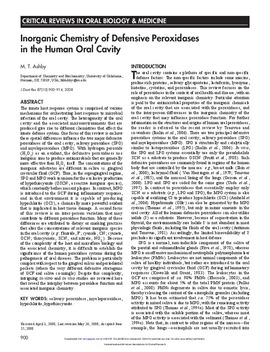| dc.contributor.author | M. T. Ashby | |
| dc.date.accessioned | 2016-01-14T19:53:50Z | |
| dc.date.accessioned | 2016-03-30T15:35:05Z | |
| dc.date.available | 2016-01-14T19:53:50Z | |
| dc.date.available | 2016-03-30T15:35:05Z | |
| dc.date.issued | 2008-10-01 | |
| dc.identifier.citation | Ashby, M. T. (2008). Inorganic Chemistry of Defensive Peroxidases in the Human Oral Cavity. Journal of Dental Research, 87(10), 900-914. doi: 10.1177/154405910808701003 | en_US |
| dc.identifier.uri | https://hdl.handle.net/11244/25483 | |
| dc.description.abstract | The innate host response system is comprised of various mechanisms for orchestrating host response to microbial infection of the oral cavity. The heterogeneity of the oral cavity and the associated microenvironments that are produced give rise to different chemistries that affect the innate defense system. One focus of this review is on how these spatial differences influence the two major defensive peroxidases of the oral cavity, salivary peroxidase (SPO) and myeloperoxidase (MPO). With hydrogen peroxide (H2O2) as an oxidant, the defensive peroxidases use inorganic ions to produce antimicrobials that are generally more effective than H2O2 itself. The concentrations of the inorganic substrates are different in saliva vs. gingival crevicular fluid (GCF). Thus, in the supragingival regime, SPO and MPO work in unison for the exclusive production of hypothiocyanite (OSCN−, a reactive inorganic species), which constantly bathes nascent plaques. In contrast, MPO is introduced to the GCF during inflammatory response, and in that environment it is capable of producing hypochlorite (OCl−), a chemically more powerful oxidant that is implicated in host tissue damage. A second focus of this review is on inter-person variation that may contribute to different peroxidase function. Many of these differences are attributed to dietary or smoking practices that alter the concentrations of relevant inorganic species in the oral cavity (e.g.: fluoride, F−; cyanide, CN−; cyanate, OCN−; thiocyanate, SCN−; and nitrate, NO3−). Because of the complexity of the host and microflora biology and the associated chemistry, it is difficult to establish the significance of the human peroxidase systems during the pathogenesis of oral diseases. The problem is particularly complex with respect to the gingival sulcus and periodontal pockets (where the very different defensive stratagems of GCF and saliva co-mingle). Despite this complexity, intriguing in vitro and in vivo studies are reviewed here that reveal the interplay between peroxidase function and associated inorganic chemistry. | en_US |
| dc.language.iso | en_US | en_US |
| dc.publisher | Journal of Dental Research | |
| dc.subject | salivary peroxidase | en_US |
| dc.subject | myeloperoxidase | en_US |
| dc.subject | hypochlorite | en_US |
| dc.subject | hypothiocyanite | en_US |
| dc.title | Inorganic Chemistry of Defensive Peroxidases in the Human Oral Cavity | en_US |
| dc.type | Research Article | en_US |
| dc.description.peerreview | Yes | en_US |
| dc.description.peerreviewnotes | https://us.sagepub.com/en-us/nam/manuscript-submission-guidelines | en_US |
| dc.identifier.doi | 10.1177/154405910808701003 | en_US |
| dc.rights.requestable | false | en_US |
